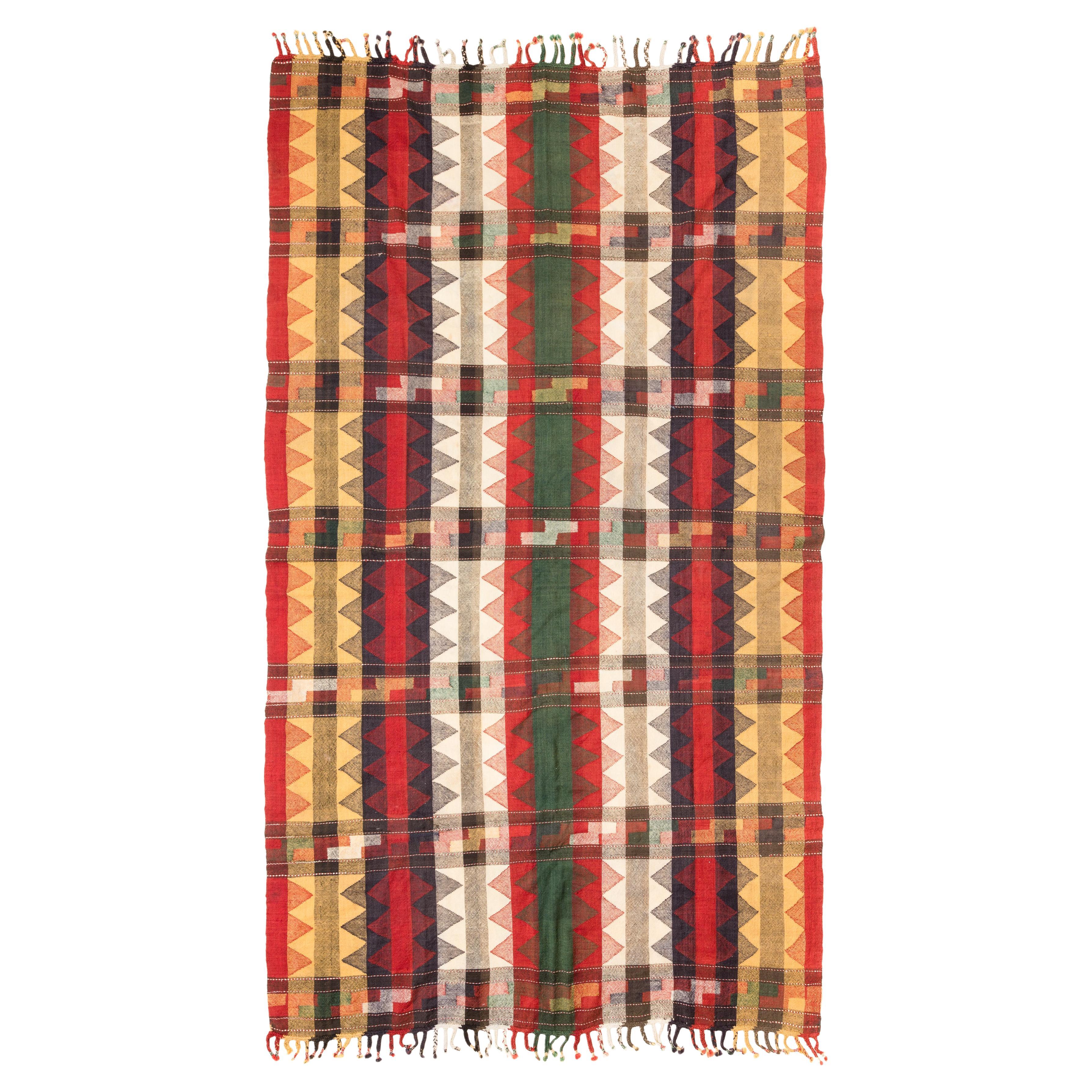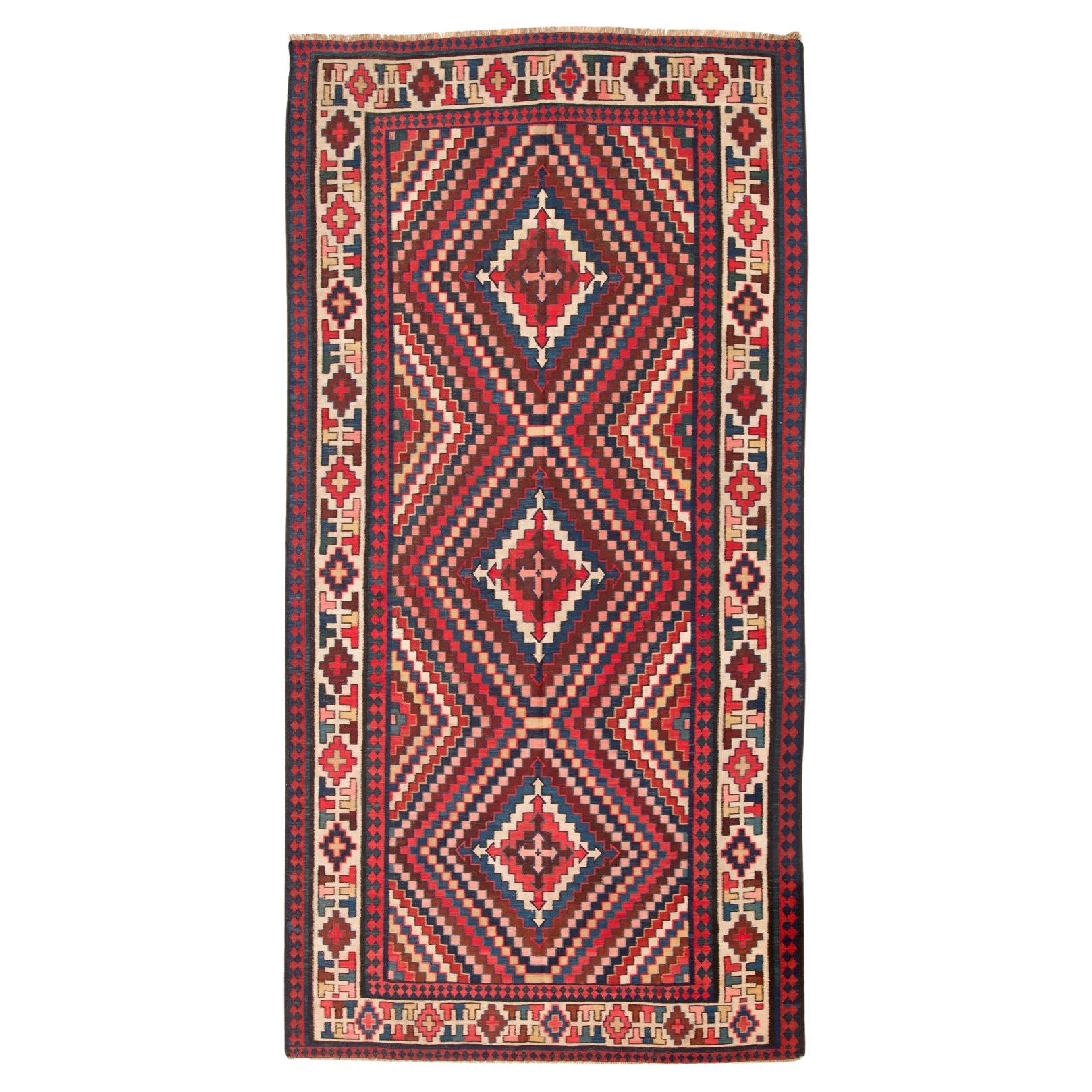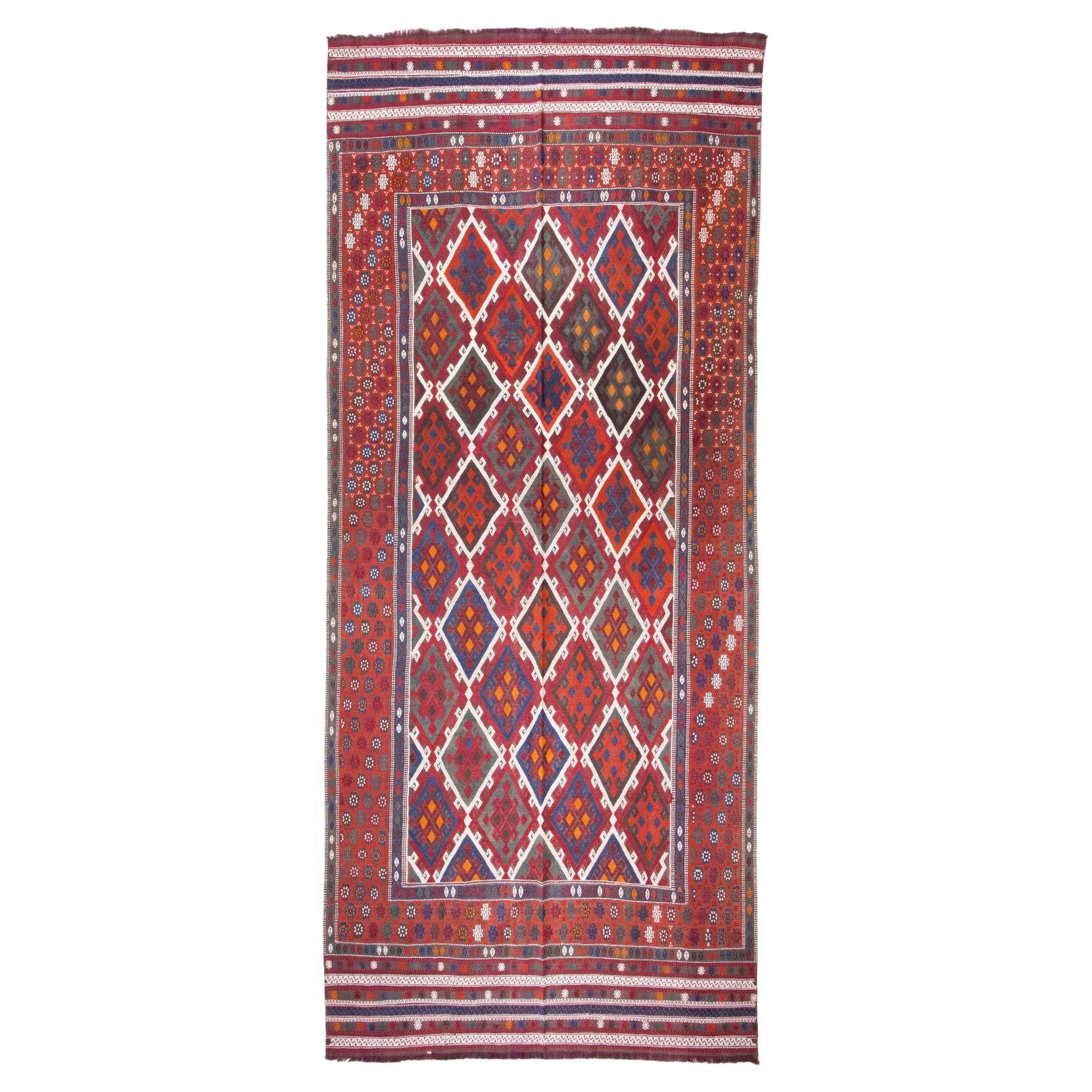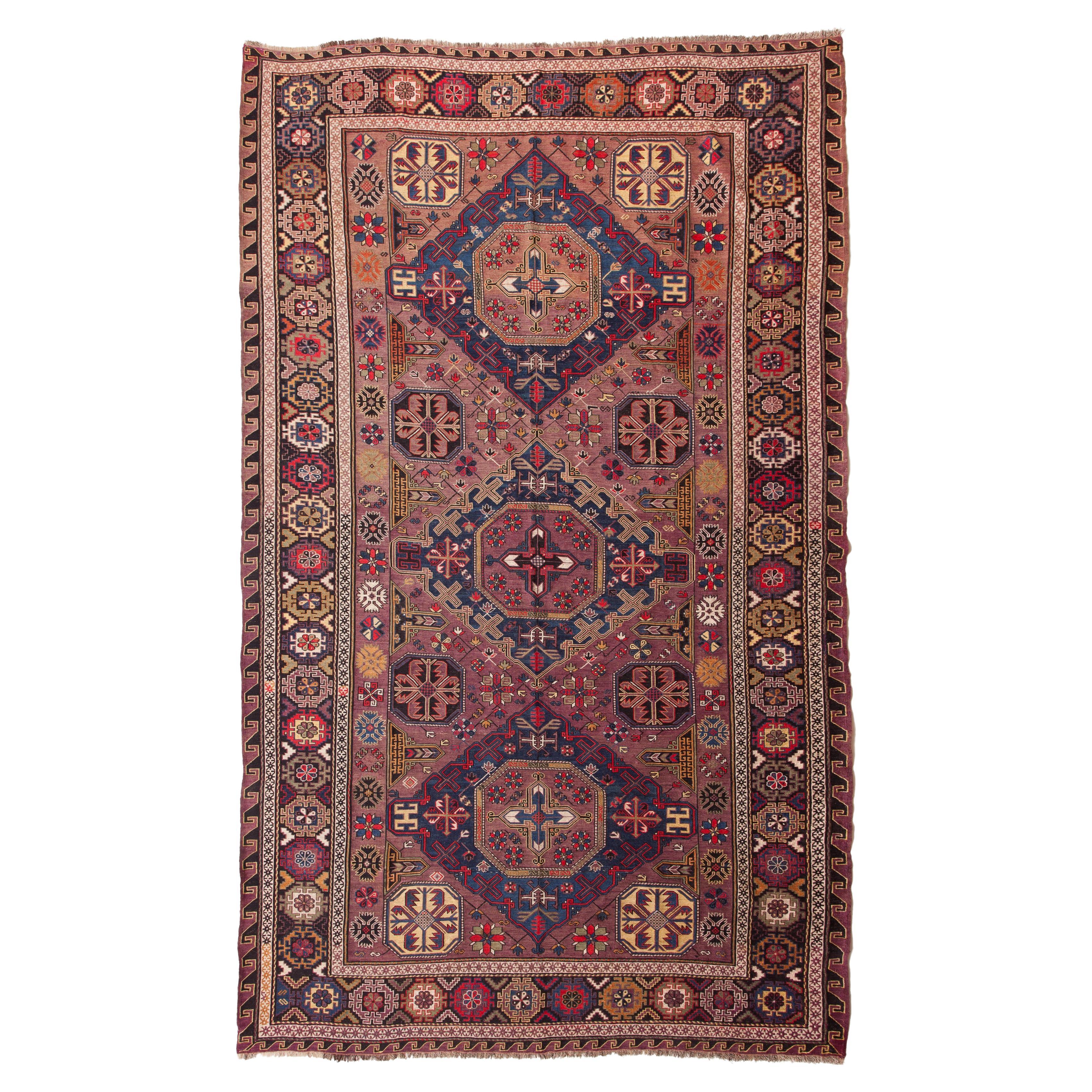Items Similar to Antique Caucasian Rug - Rare Caucasian Carpet, Caucasus Rug, Antique Rug
Video Loading
Want more images or videos?
Request additional images or videos from the seller
1 of 7
Antique Caucasian Rug - Rare Caucasian Carpet, Caucasus Rug, Antique Rug
About the Item
Rare Caucasian Rug Caucasus Rug
Size: 176×224 cm
This wonderful rug is a formerly unpublished addition to a small and rare group of blue-ground Caucasian rugs whose design is dominated by a prominent decahedral gabled ivory medallion. The overall pattern echoes that of a group of earlier 17th and 18th century north west Persian carpets, whose designs were based upon the Persian garden plan known as the “Four Gardens” or Chahar Bagh (M.S.Dimand & J. Mailey, Oriental Rugs in the Metropolitan Museum of Art, New York, 1973, p.84, fig.116). The smaller lozenges that extend above and below the central medallion on the present lot, are linked by a narrow vertical channel which represents the streams and ornamental pools that feed the flowering trees and shrubs on either side. The once eight-pointed medallion, that is an archaic form found in early Anatolian and Caucasian rugs, and which continues to be used throughout the nineteenth century in Fachralo rugs, here has been simplified to just six points. Further more, the formerly square compartments filled with trees, are replaced here with “Memling” guls, most commonly associated with the weavings from the Moghan district in the Caucasus.
The motif that remains open to interpretation however, is the zoomorphic form within each corner of the ivory medallion. Although they resemble four-legged animals with a blunt hammer-head, it is more probable that these heavily abstracted forms represent the branched fruiting trees, that became increasingly geometric in form in the ‘Garden’ carpets woven in the latter years of the 18th century.
Eight other examples have been published, one in the Rudnick Collection, which is dated and most likely reads 1833 (J. Bailey and M. Hopkins, Through the Collector’s Eye – Oriental Carpets from New England Private Collections, Providence Rhode Island 1991, p.66, no.20); one by E. Gans-Ruedin, Caucasian Carpets, New York, 1986, pl.118, two by Eberhart Herrmann; the first dated to either 1844 or 1850 (E. Herrmann, Seltene Orienteppiche IV, Munich, 1982, p.152, no.46 and Herrmann, Kaukasische Teppichkunst Im 19. Jahrhundert Ein Bilderbuch, Munich 1993, p.61, pl.45); one of slightly shortened proportions by Ian Bennett, (Bennett, Oriental Rugs, Volume I Caucasian, London, 1981, p.79, no.66), two examples that sold at auction in the same week; Sotheby’s London, 28 April 1993, lot 16 and Christie’s London, 29 April 1993, lot 357, and the most recent to appear on the market which sold in these Rooms, 26 October 2017, lot 313. The Gans-Ruedin and Bennett examples, display two columns of double ‘Memling’ guls above and below the central medallion while the others all have three.
Apart from the Rudnick example which has a ‘Shield’ border, all of the other rugs share the same border pattern that consists of a series of small hexagons enclosing a large ‘S’ motif, with every other hexagon set within paired double-ended zoomorphs. The origin of this design stems from earlier Caucasian ‘Dragon’ carpets, and is almost identical to that of an eighteenth century east Caucasian rug, formerly in the collection of the late Peter Lehmann-Bärenklau, which sold in these Rooms, 19 April 2016, lot 20. The border is most frequently flanked by white ground guard stripes which display small flowerheads with a further inner frame of small space-invader motifs. Unique to the group, the present lot has an arrangement of small alternating yellow and ivory flower heads forming an additional frame within the central field which also sees the inclusion of two human figures flanking the central medallion.
- Dimensions:Width: 69.3 in (176 cm)Length: 88.19 in (224 cm)
- Materials and Techniques:
- Place of Origin:
- Period:
- Date of Manufacture:1800's
- Condition:
- Seller Location:Sultanahmet, TR
- Reference Number:1stDibs: LU7849238014192
About the Seller
3.0
Vetted Seller
These experienced sellers undergo a comprehensive evaluation by our team of in-house experts.
Established in 1989
1stDibs seller since 2022
Typical response time: 4 hours
- ShippingRetrieving quote...Ships From: Sultanahmet, Turkey
- Return PolicyA return for this item may be initiated within 14 days of delivery.
More From This SellerView All
- Antique Shirvan Rug - 19th Century Caucasian Shirvan Rug, Caucasus RugLocated in Sultanahmet, 34Antique Shirvan Rug Caucasus Rug 19th Century Caucasian Shirvan Rug Size: 130x228 cm An Authentic Work of Art: 19th Century Caucasian Shirvan Carpet If you want to add an authenti...Category
Antique 19th Century Caucasian Caucasian Rugs
MaterialsWool
- Antique Caucasian Talish Rug - 19th Century South East Caucasus Rug, Antique RugLocated in Sultanahmet, 34Caucasian Talish Rug Caucasus Rug South East Caucasus, Moghan region Talish Rug Second half 19th Century South East Caucasus, Moghan region Talish Rug A rare Moghan woven in a long...Category
Antique 19th Century Caucasian Caucasian Rugs
MaterialsWool
- Middle of 19th Century Caucasian Prayer Kuba Rug, Antique Rug, Caucasus RugLocated in Sultanahmet, 34Prayer Kuba Rug | Caucasus Rug Middle of 19th Century Caucasian Prayer Kuba Rug Kuba carpet, floor covering from the Caucasus woven around Kuba (now Kuba) in northern Azerbaijan. Se...Category
Antique Mid-19th Century Caucasian Caucasian Rugs
MaterialsWool
- South East Caucasus, Moghan region Talish Rug, Antique Rug, Caucasus RugLocated in Sultanahmet, 34Caucasian Talish Rug Caucasus Rug South East Caucasus, Moghan region Talish Rug Second half 19th Century South East Caucasus, Moghan region Talish Rug A rare Moghan woven in a long...Category
Antique 19th Century Caucasian Caucasian Rugs
MaterialsWool
- Antique Caucasian Rug - 19th Century Antique Caucasian Rug, Antique RugLocated in Sultanahmet, 34Antique Caucasian Rug 19th Century Antique Caucasian Rug Size: 142x234 cm 7,90x7,67 Ft This 19th-century Caucasian rug adds nobility to any space with its historical beauty and art...Category
Antique 19th Century Caucasian Caucasian Rugs
MaterialsWool
- Antique Shirvan Prayer Rug - Circa 1870, Antique Rug, Caucasus RugLocated in Sultanahmet, 34Caucasian Prayer Shirvan Rug Circa 1870 Size: 135 x 168 cm This impressive antique Caucasian Shirvan rug from the 1870s reflects the exquisite artistry and mastery of a historic pe...Category
Antique Mid-19th Century Caucasian Caucasian Rugs
MaterialsWool
You May Also Like
- Antique Caucasian Runner Rug, Caucasus CarpetLocated in Tokyo, JPThis is an antique runner rug from the Caucasus region with a rare and beautiful color composition. Of all the rugs of the oriental world, it is the work of the Caucasian weavers ...Category
Early 20th Century Caucasian Oushak Caucasian Rugs
MaterialsWool, Natural Fiber
- Antique Caucasus Verneh Kilim Rug, Caucasian CarpetLocated in Tokyo, JPThis is a large Antique Verneh Kilim from the Caucasus region with a rare and beautiful color composition. Of the four countries that make up the Caucasus, Azerbaijan produces the most kilims, and the land has a long history of weaving. The nomadic tribes wove kilims and carpets as well as a wide range of storage bags and sacks, such as saffrash, khurgin and chula, and donkey and horse trappings. Smaller bags...Category
Early 20th Century Caucasian Kilim Caucasian Rugs
MaterialsWool, Natural Fiber
- Antique Caucasus Talish Kilim Rug, Caucasian CarpetLocated in Tokyo, JPThis is a large Antique Talish Kilim from the Caucasus region with a rare and beautiful color composition. Of the four countries that make up the Caucasus, Azerbaijan produces the m...Category
Early 20th Century Caucasian Kilim Caucasian Rugs
MaterialsWool, Natural Fiber
- Antique Caucasus Verneh Kilim Rug, Caucasian CarpetLocated in Tokyo, JPThis is a large Antique Verneh Kilim from the Caucasus region with a rare and beautiful color composition. Of the four countries that make up the Caucasus, Azerbaijan produces the...Category
Early 20th Century Caucasian Kilim Caucasian Rugs
MaterialsWool, Natural Fiber
- Antique Caucasus Soumak Kilim Rug, Caucasian CarpetLocated in Tokyo, JPThis is an Antique Soumak ( Sumak, Sumac ) Kilim from the Caucasus region with a rare and beautiful color composition. Of the four countries that make up the Caucasus, Azerbaijan produces the most kilims, and the land has a long history of weaving. The nomadic tribes wove kilims and carpets as well as a wide range of storage bags and sacks, such as saffrash, khurgin and chula, and donkey and horse trappings. Smaller bags for salt, utensils, and other items are also common. Not only are the Azerbaijani weavers prolific, but they also employ many techniques at the loom. These include slitweave- known locally by the word Kilim, warp-faced patterning (jajim), supplementary weft (zili), weft wrapping (popularly known as soumak), and extra weft wrapping (verneh). Furthermore, flatweaves are defined by regional names such as palas and shadda, so it is possible to ascribe a variety of weaving names to particular provenances as follows: soumaks are made in Kuba, palas, and kilims in Hajikabul, zili in Khizy, verneh and zili in Kazakh, shadda, verneh and zili in Barda, jajim in Agjabedi, and palas and kilims in Jabrail. Soumak weave is a technique in which weft threads are added to a plain weave fabric, and one or two warp threads are wound from the front to the back. The resulting Kilim is denser and firmer, giving it a unique feel and look. This technique is commonly used in the Caucasus region. Soumak kilims have a very beautiful contrast between orange that shines like the sun, deep purple-tinged indigo, and astringent dark red. You can also see the unevenly dyed abrage in this Soumak, which is like a magic carpet with an oriental atmosphere. Features of the Caucasian Kilim, such as the unique cosmic geometric floral pattern, are also found in this Soumak which has a bright look, but it also has a faded and textured feel, so it can be used in a good old atmosphere. The woven fabric is particularly solid, so it is recommended for use in a solid living room or under a dining table without moving or twisting. A nice Kilim under a long wooden dining table.Category
Antique Late 19th Century Caucasian Kilim Caucasian Rugs
MaterialsWool, Natural Fiber
- Antique Caucasus Soumak Kilim Rug, Caucasian CarpetLocated in Tokyo, JPThis is a large Antique Soumak ( Sumak, Sumac ) Kilim from the Caucasus region with a rare and beautiful color composition. Of the four countries that make up the Caucasus, Azerbaijan produces the most kilims, and the land has a long history of weaving. The nomadic tribes wove kilims and carpets as well as a wide range of storage bags and sacks, such as saffrash, khurgin and chula, and donkey and horse trappings. Smaller bags for salt, utensils, and other items are also common. Not only are the Azerbaijani weavers prolific, but they also employ many techniques at the loom. These include slitweave- known locally by the word kilim, warp-faced patterning (jajim), supplementary weft (zili), weft wrapping (popularly known as soumak), and extra weft wrapping (verneh). Furthermore, flatweaves are defined by regional names such as palas and shadda, so it is possible to ascribe a variety of weaving names to particular provenances as follows: soumaks are made in Kuba, palas, and kilims in Hajikabul, zili in Khizy, verneh and zili in Kazakh, shadda, verneh and zili in Barda, jajim in Agjabedi, and palas and kilims in Jabrail. Soumak weave is a technique in which new weft threads are added to a plain weave fabric, and one or two warp threads are wound from the front to the back. The resulting kilim is denser and firmer, giving it a unique feel and look. This technique is commonly used in the Caucasus region. Soumak Kilims have a very beautiful contrast between orange that shines like the sun, deep purple-tinged indigo, and astringent dark red. You can also see the unevenly dyed abrage in this sumac, which is like a magic carpet with an oriental atmosphere. Features of the Caucasian kilim, such as the unique cosmic geometric floral pattern, are also found in this Soumak. It has a bright look, but it also has a faded and textured feel, so it can be used in a good old atmosphere. The woven fabric is particularly solid, so it is recommended for use in a solid living room or under a dining table without moving or twisting. A nice kilim under a long wooden dining table.Category
Early 20th Century Caucasian Kilim Caucasian Rugs
MaterialsWool, Natural Fiber





